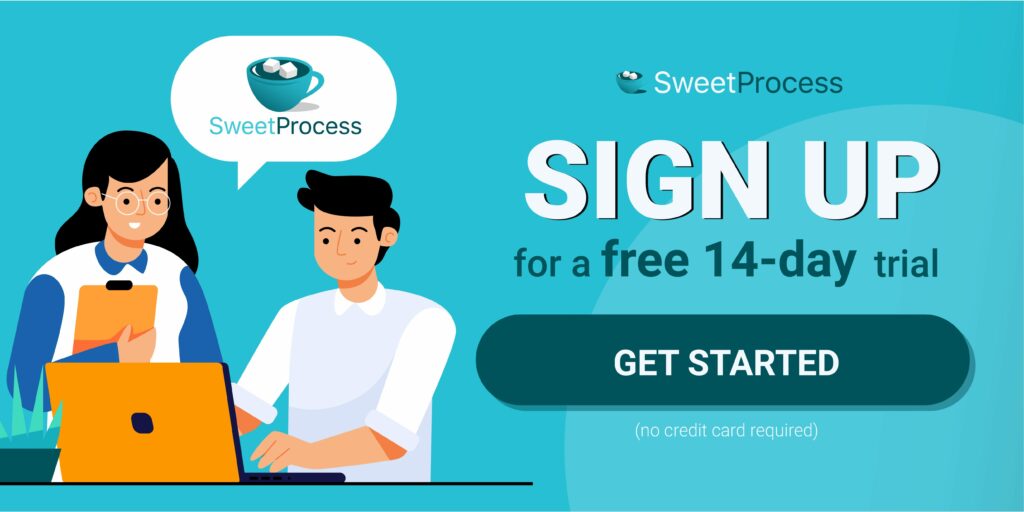Last Updated on February 21, 2025 by Owen McGab Enaohwo
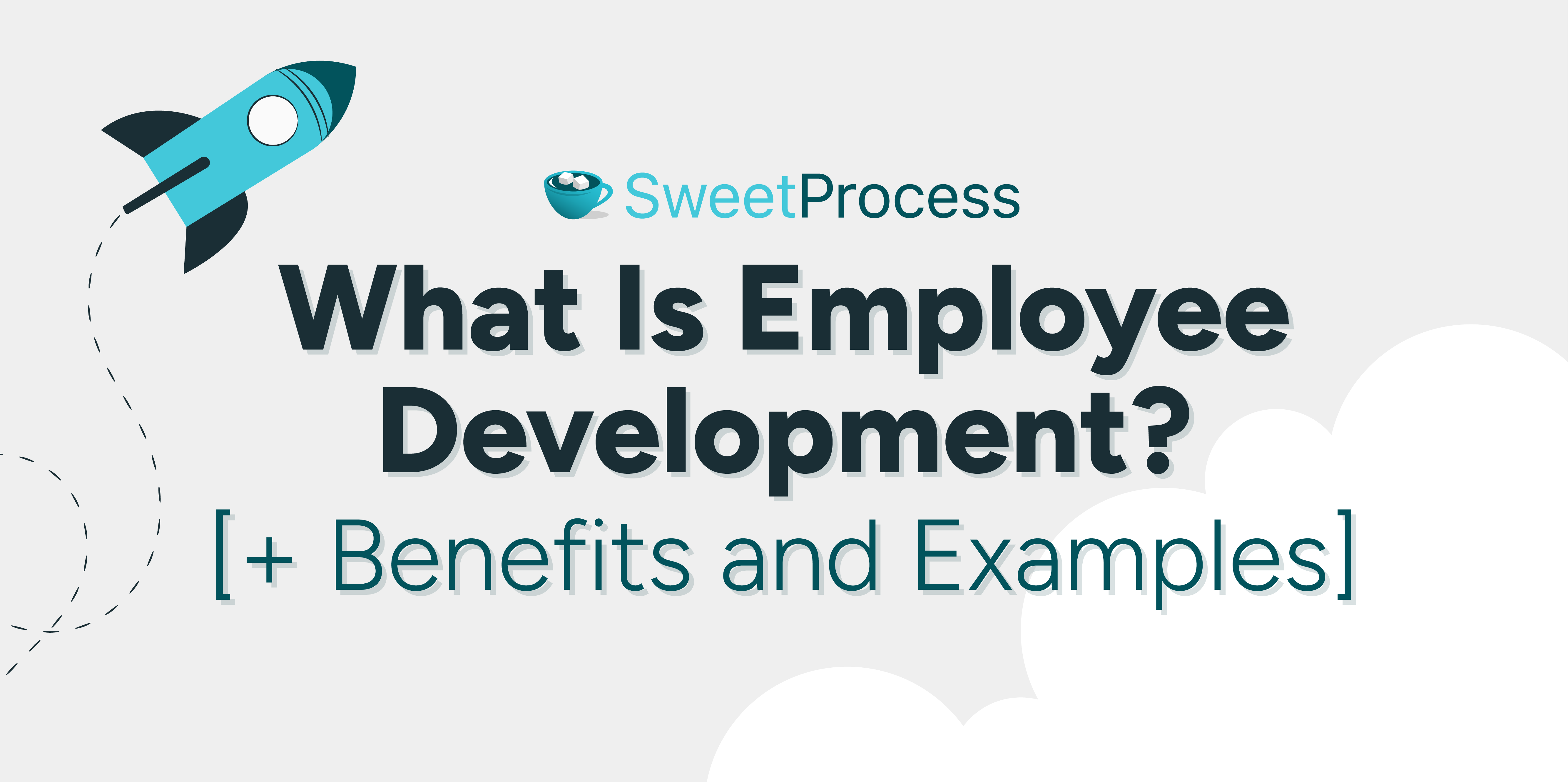
Employee development isn’t just a nice to have—it’s an essential ingredient for retaining top talent and fostering business success. According to Go2HR, 40% of employees who receive poor training leave their jobs within the first year, and companies lose more than $500 billion every year due to employee disengagement.
These statistics highlight a harsh reality: organizations that neglect to invest in their employees’ development risk higher turnover, disengagement, and lower productivity.
To avoid these pitfalls, it’s essential to prioritize employee development in your organization. If this is your goal, you’re in the right place. Discover practical strategies and the significant benefits of investing in your team’s growth.
By claiming a 14-day free trial of SweetProcess, you can explore its powerful features to streamline and standardize employee development processes in your organization.
What You’ll Learn In This Guide:
Why Is Employee Development Important in an Organization?
How to Manage Your Employees’ Development Using SweetProcess
10 Proven Employee Development Methods
Challenges of Employee Development and How to Overcome Them
Implementing Employee Development in an Organization: Different Approaches To Explore
Stages of Employee Development
Streamline Your Employee Development Using SweetProcess
What Is Employee Development?
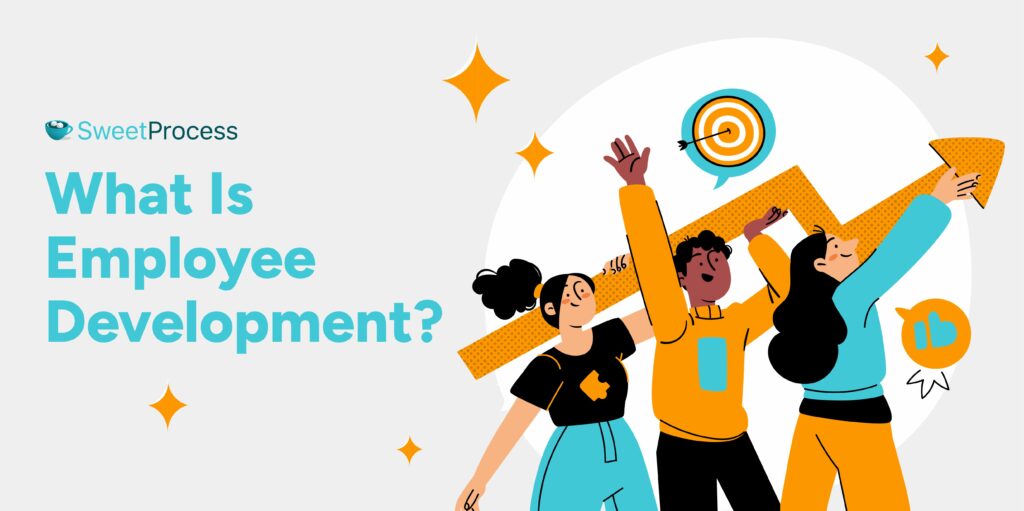
Employee development is continuously improving employees’ skills, knowledge, and abilities to help them achieve their professional goals. In addition to building your employees, employee development contributes significantly to the organization’s success.
It involves structured initiatives such as training programs, mentoring, coaching, performance evaluations, and skill-building opportunities designed to enhance technical and soft skills.
The 2024 LinkedIn Workplace Learning Report reveals that 94% of employees would stay longer in a company that invests in their career development.
The ultimate goal of employee development is to create a culture of growth and learning that benefits both the individual and the organization. This will lead to increased engagement, higher retention rates, and a stronger competitive edge in the market.
Employee development is not a one-size-fits-all approach. It involves programs tailored to employees’ aspirations and the company’s strategic objectives. For example, a project manager might benefit from leadership training or advanced project management certifications, while an entry-level employee may need foundational skills like communication and time management.
Why Is Employee Development Important in an Organization?
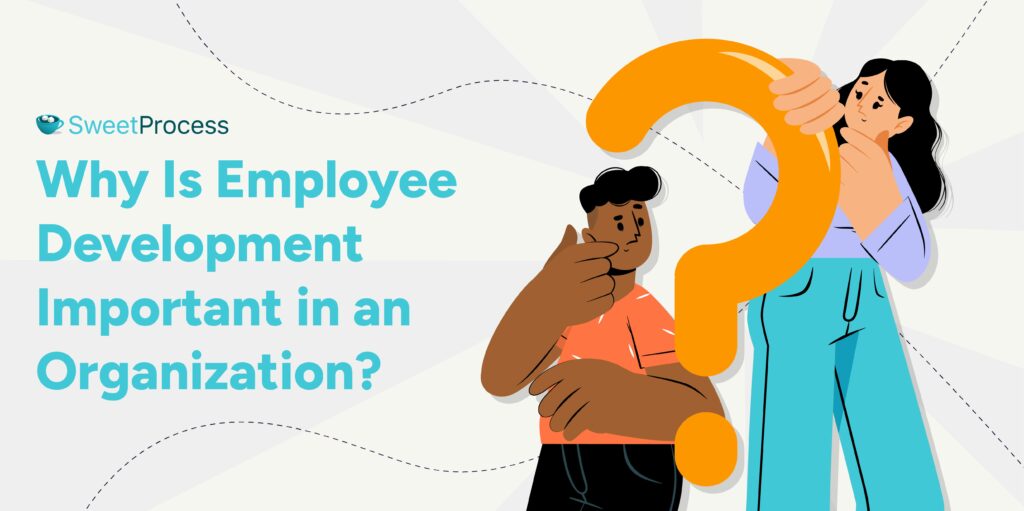
Employee development is vital for building a skilled, motivated, adaptable workforce. It ensures improved performance, leadership growth, and alignment with organizational goals. Other importance of employee development are:
Builds Professional Relationships
Employee development fosters collaboration and communication, which are critical for building strong professional relationships within an organization. Training sessions, mentorship programs, and team-building activities create development opportunities for employees to interact, share ideas, and learn from one another.
For example, cross-functional training allows employees from different departments to work together, fostering a sense of camaraderie and mutual respect that can lead to better collaboration and more innovative solutions.
Performance Improvement
One of the most significant benefits of employee development is its direct impact on performance. Organizations can see measurable productivity, quality, and efficiency improvements by equipping employees with the skills and knowledge they need to excel in their roles. When employees are given the tools and confidence to perform at their best, it’s a win-win for both the employees and the organization.
Attracting Skilled Job Candidates
Organizations that invest in employee development are more attractive to top talent. Skilled candidates seek opportunities to grow professionally and personally, and a strong development program signals a company’s commitment to its workforce.
This is why AT&T’s $1 billion workforce 2020 initiative helped them to attract top talent and boost employee retention.
Boosts the Performance of Employees
When employees feel supported in their professional journey, their performance will naturally grow. A 2023 Gallup study revealed that organizations with highly engaged employees outperform their competitors in profitability by 23%.
Development programs are tailored to individual strengths and areas for growth. Such programs help employees feel more confident and engaged in their development journey. This will lead to a ripple effect, where motivated employees contribute more effectively to projects and help drive the organization’s success.
Develop Leaders for the Future
Effective employee development prepares the next generation of leaders within an organization. Leadership training, succession planning, and mentorship programs ensure a steady pipeline of capable individuals ready to step into key roles as the company evolves.
An example is IBM’s leadership development program, which focuses on identifying high-potential employees and equipping them with strategic thinking, decision-making, and innovation skills through mentorship and rotational assignments. This initiative has helped IBM create a strong pipeline of future leaders, ensuring organizational continuity and a competitive edge in adapting to market changes.
For any organization, investing in leadership growth ensures smooth transitions and fosters a culture of empowerment and accountability across all levels.
Lower Staff Turnover
High employee turnover can be costly and disruptive. Development opportunities are a powerful retention tool, showing employees that the organization values their growth and career progression. As a case study, Amazon has a career choice program covering up to 95% of tuition for employees pursuing in-demand skills, even for roles outside the company. This program demonstrates Amazon’s commitment to employee growth and has significantly reduced turnover among frontline workers, fostering loyalty and increasing long-term retention.
Cost Savings
While employee development programs require an initial investment, they can lead to significant long-term cost savings. Training existing employees is far less expensive than recruiting and onboarding new talent. Additionally, a well-trained workforce is less likely to make costly mistakes, thus maintaining efficiency.
For instance, IBM found that every dollar spent on training yields a $30 return in productivity gains. Organizations can achieve better financial outcomes by prioritizing employee development while enhancing overall performance.
How to Manage Your Employees’ Development Using SweetProcess
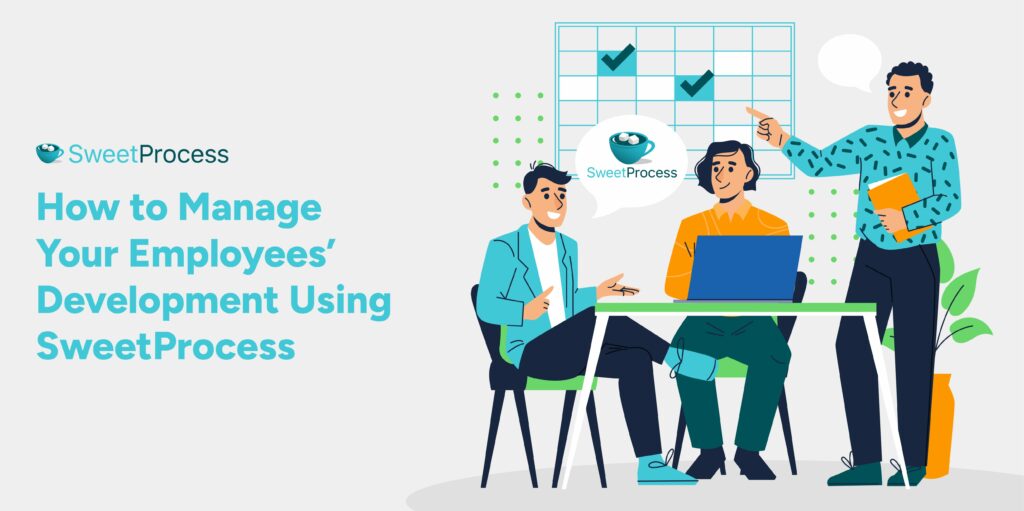
You can turn knowledge into unstoppable actions with the right tools in skilled hands. This is what SweetProcess does for you in the process of employe development. It’s hard to find tools with all the features you can find in SweetProcess.
From process documentation, policy documentation, standard operating procedure documentation, and knowledge base creation to its training and assessment features, you have a lot to explore on SweetProcess. Some of the highlights are discussed below:
Build a Quiz to Assess Your Team’s Grasp of Company Policies, Processes, and Procedures
One key step to fostering employee development is ensuring your team fully understands the company’s policies, processes, and procedures. SweetProcess simplifies this by allowing you to create interactive quizzes around your employee development training.
These quizzes help identify knowledge gaps and provide actionable insights into areas where additional training may be required. Here’s how to create a quiz in SweetProcess:
Step 1: Log in to your SweetProcess account or create a new account for free.
Step 2: On the SweetProcess home page, click on “More” and select “Quizzes.”
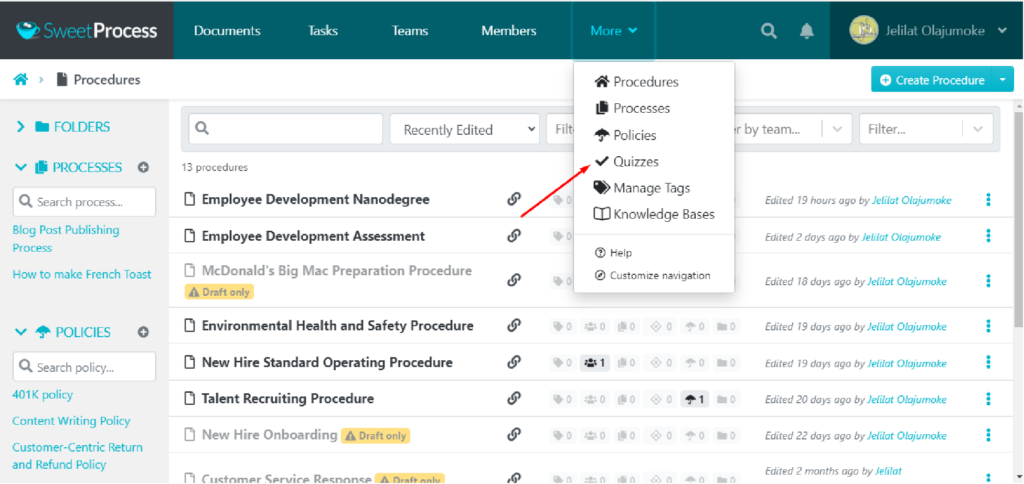
Step 3: Select “Create Quiz.”
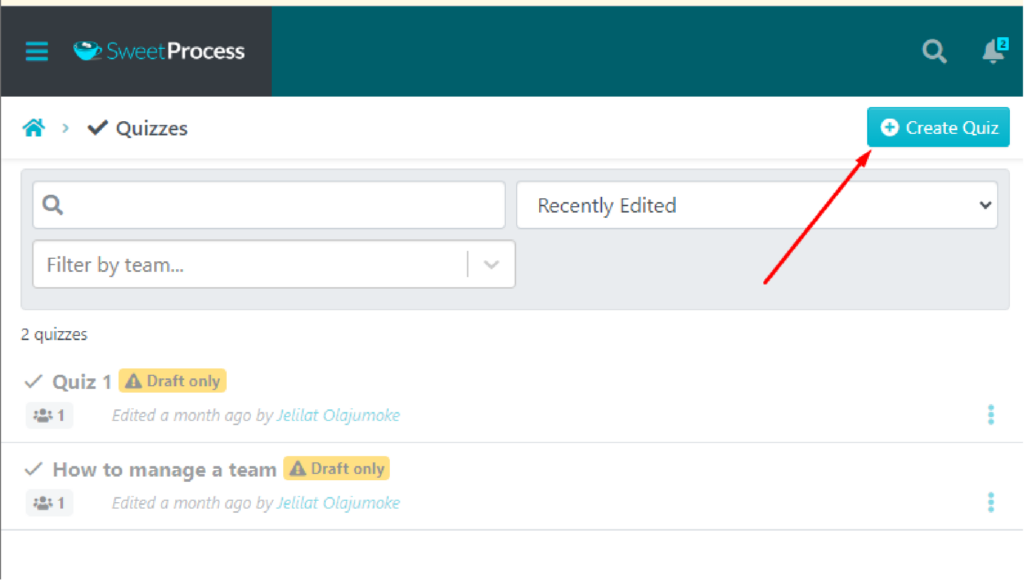
Step 4: Give the quiz a name.
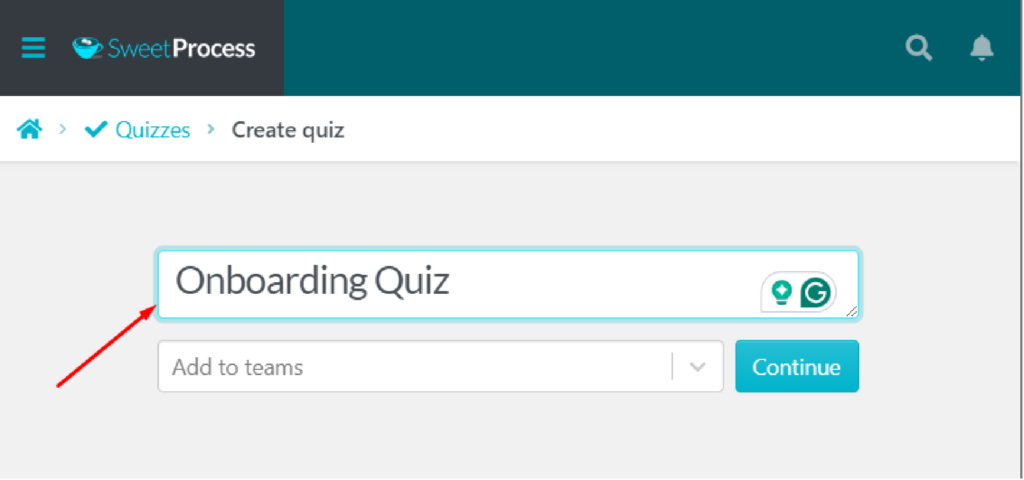
Step 5: Assign the quiz to the appropriate team on SweetProcess and click “Continue.”
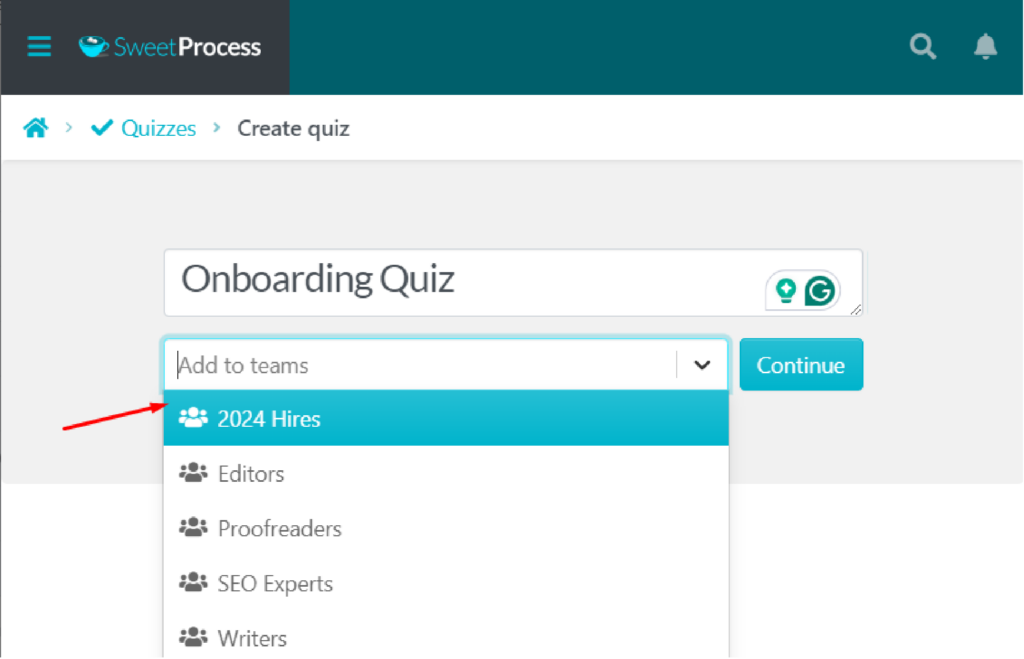
Step 6: Now, you can begin crafting multiple-choice questions that relate to your company’s training, procedures, policies, or processes.
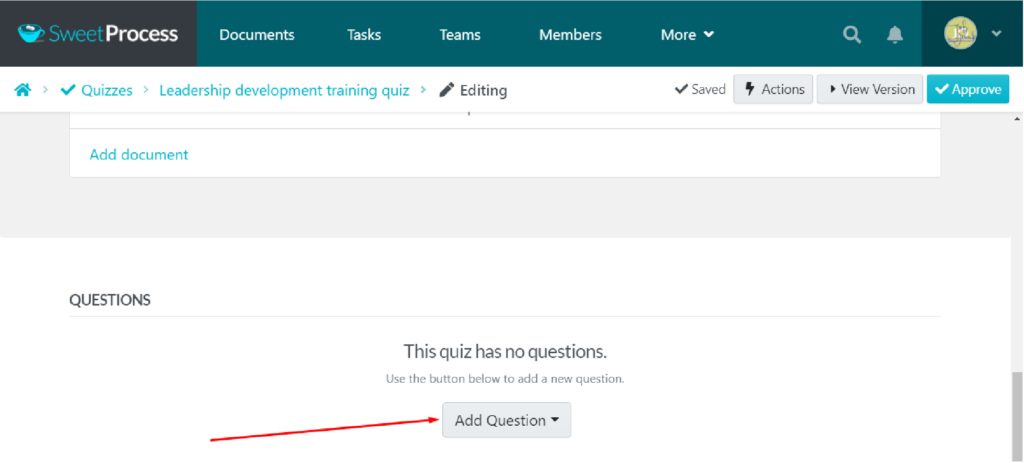
Step 7: Choose the type of quiz: multiple-choice or open-ended answer.
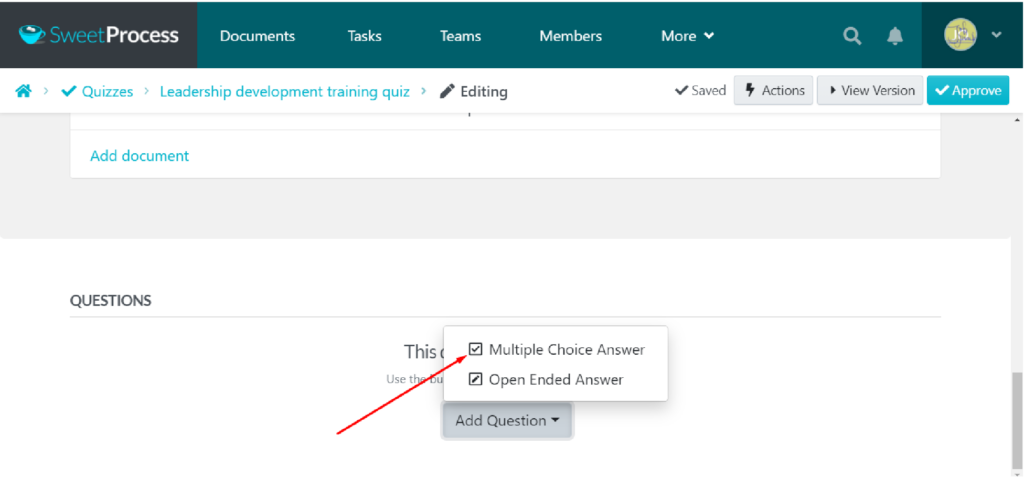
Step 8: Click anywhere above the question section to assign duration and pass marks for the quiz.
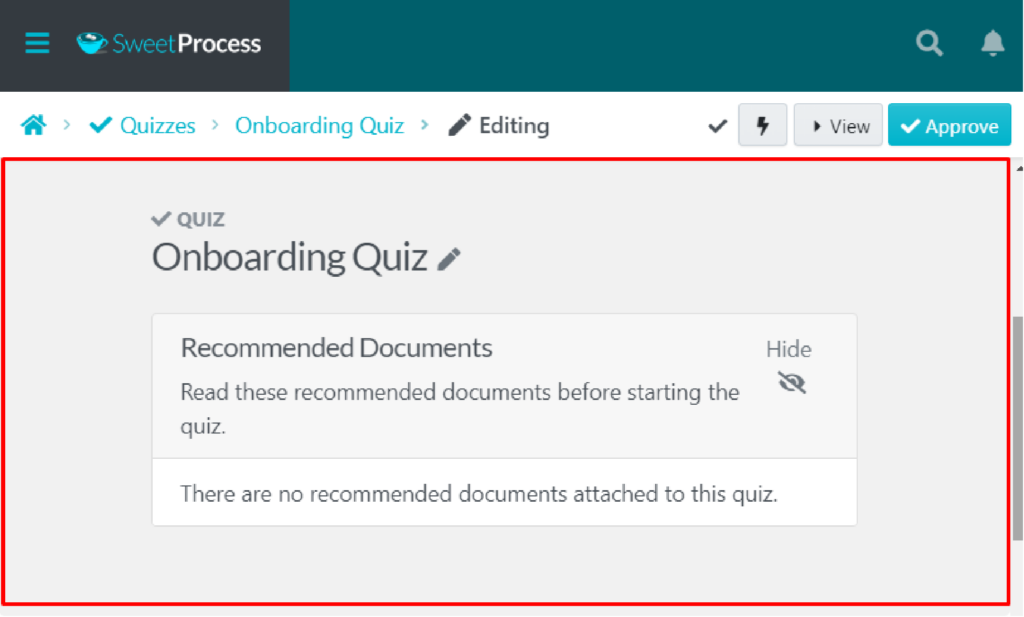
Step 9: Click “Save changes” after selecting your preferred duration and pass mark.
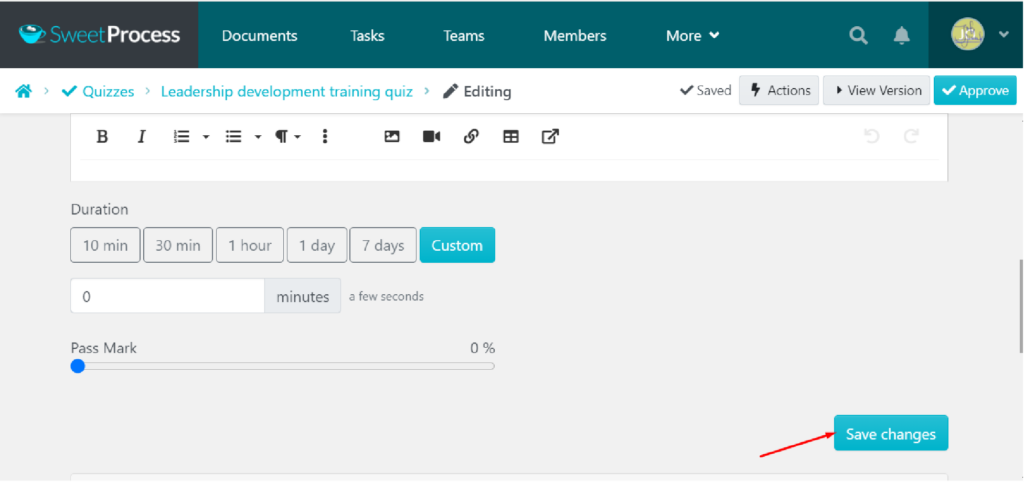
Step 10: Attach one or more documents related to this quiz to enable a cohesive learning and testing environment.

Step 11: Approve the quiz after adding all the questions as required.
Sign up here to create your first quiz in SweetProcess at no cost.
Turn Existing Procedures and Policies Into a Knowledge Base for Employees
SweetProcess enables you to transform scattered documents and policies into a centralized knowledge base, making it easy for employees to access important information anytime.
In other words, you can consolidate your training and operational manuals, HR policies, and team workflows into a single, searchable wiki, making it easy for employees to find the information they need quickly and independently.
Here’s how to add an existing SOP document to a knowledge base:
Step 1: Log in to your SweetProcess account or create a new account for free.
Step 2: Open the specific SOP and click on “Actions.”
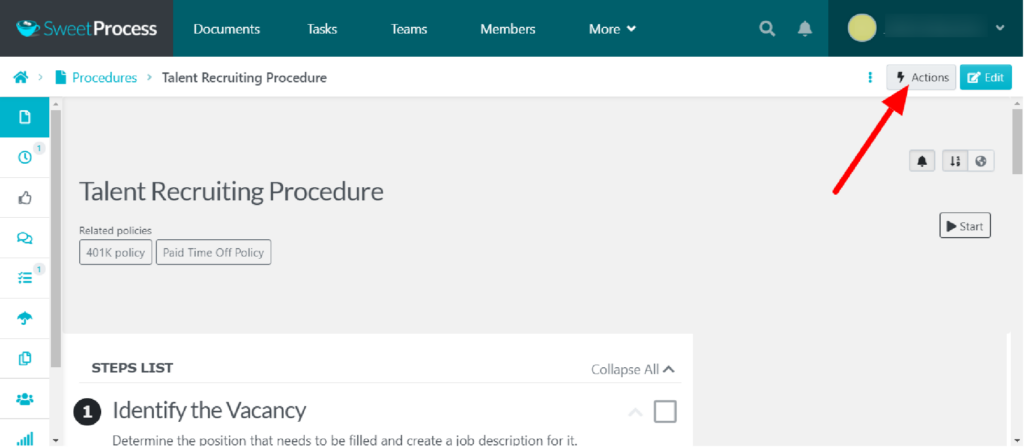
Step 3: On the dropdown menu, select “Knowledge Base.”
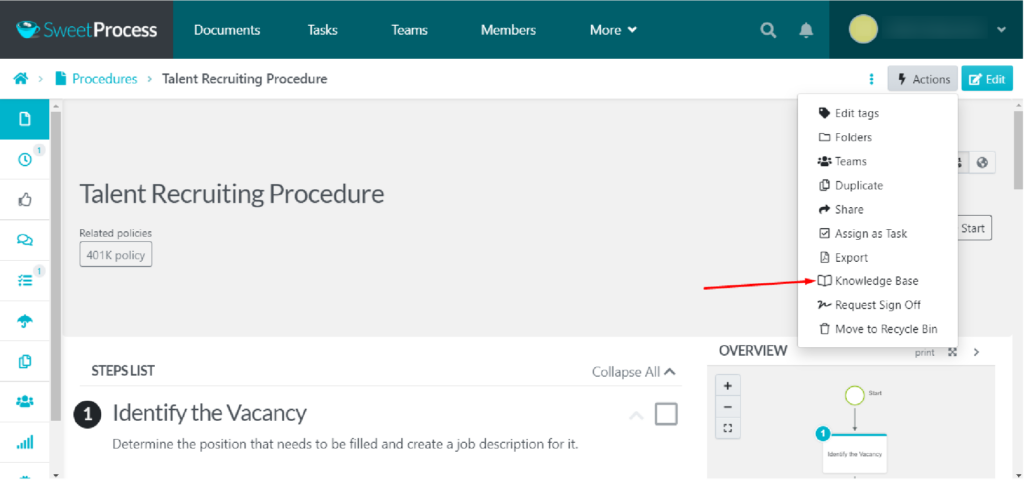
Step 4: Select the category you want to add to the SOP or create a new category.
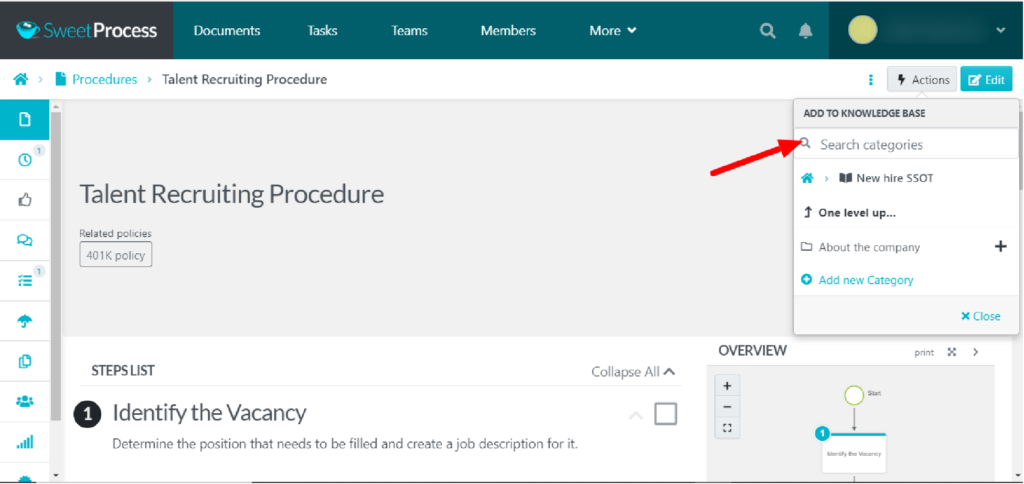
Step 5: Clicking on the plus (+) sign adds the document to your knowledge base.
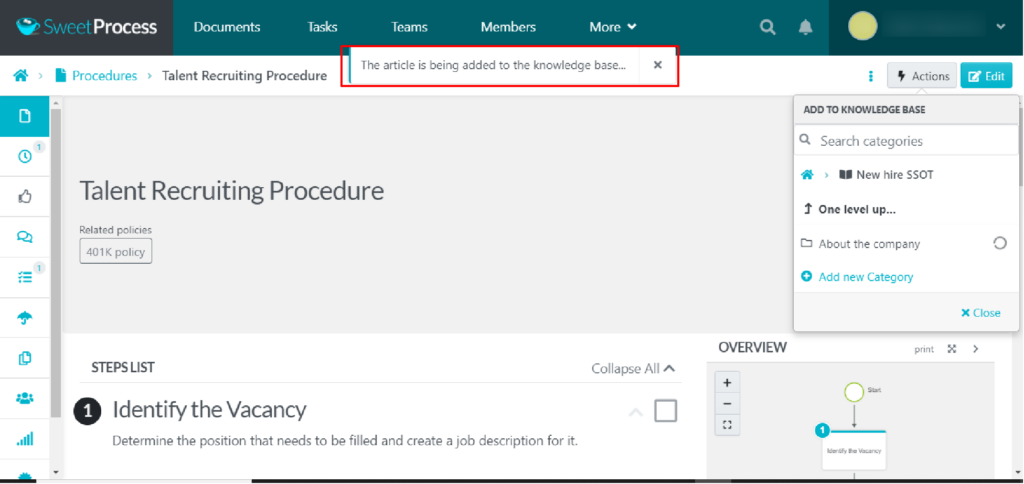
You can also write a knowledge base article from scratch following the steps below:
Step 1: Log in to your SweetProcess account or create a new account for free.
Step 2: Click “More” and select “Knowledge Bases.”
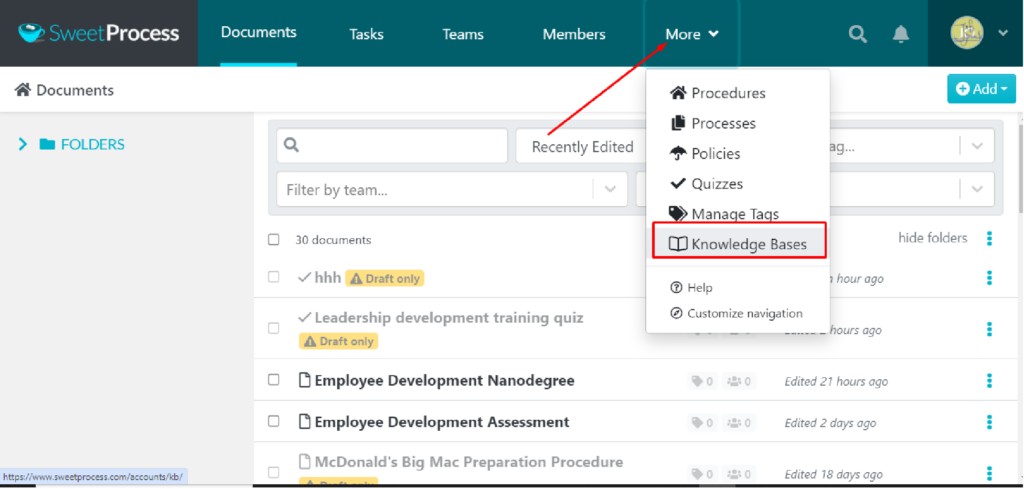
Step 3: Click “Create Knowledge base.”

Step 4: Name the knowledge base and click “Continue.”

Step 5: On the interface displayed, click “Control Access” to switch between public and private knowledge bases.
Note: Private knowledge bases can only be accessed by your employees, while anyone on the web can access the public knowledge base.
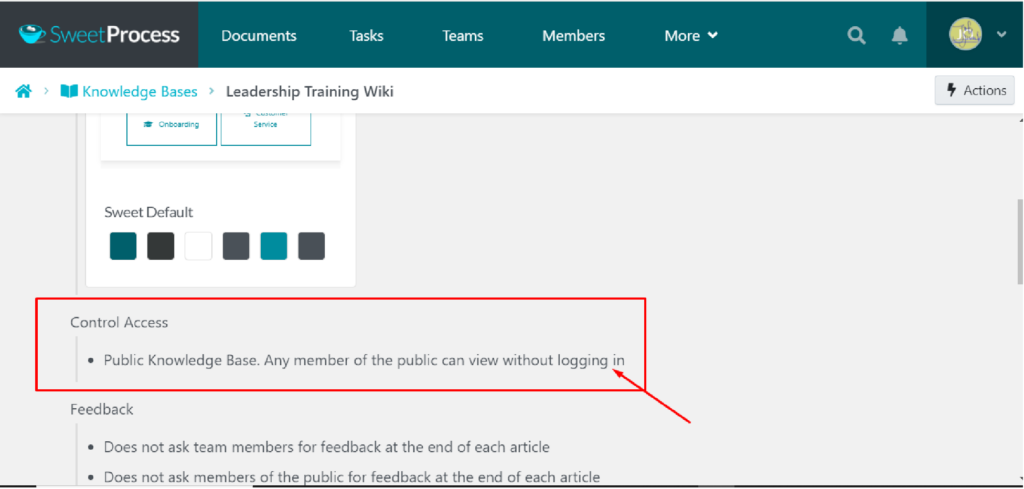
Step 6: Select “Private Knowledge Base” if you intend to dedicate it to your employees.
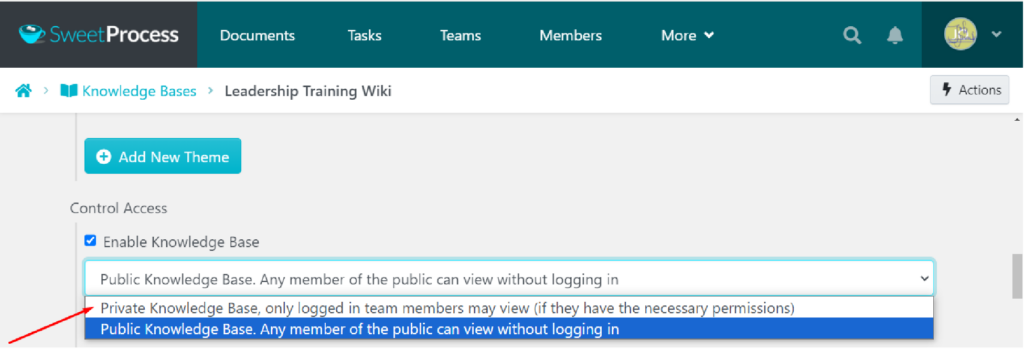
Also, choose your desired preference for other options on the control page.
Step 7: Start by creating your first category or section. Click on “Create Category.”
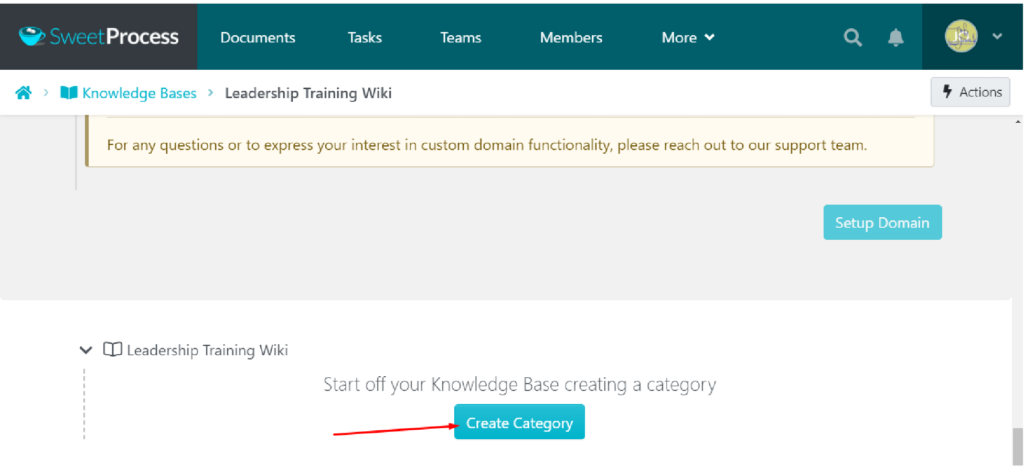
Step 8: Add your desired categories.
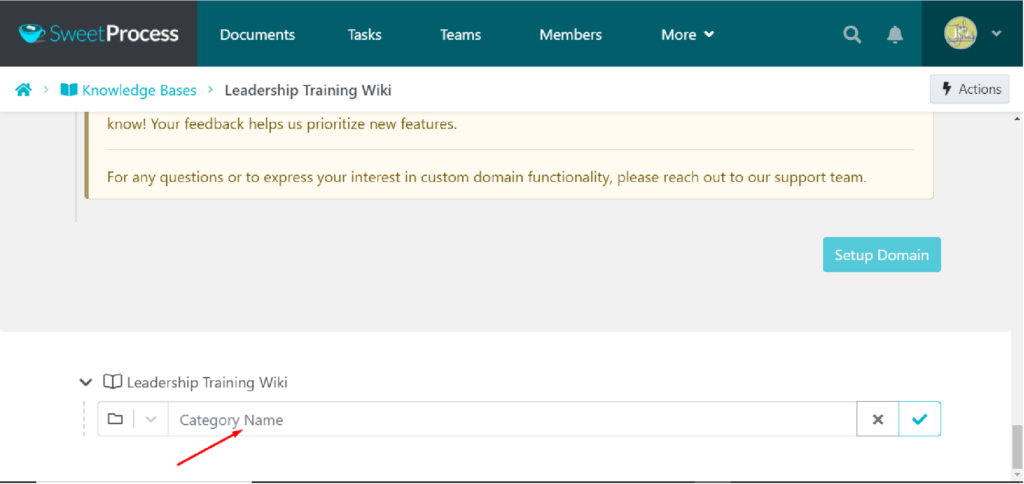
Step 9: Populate the knowledge base by adding existing documents or creating new ones.
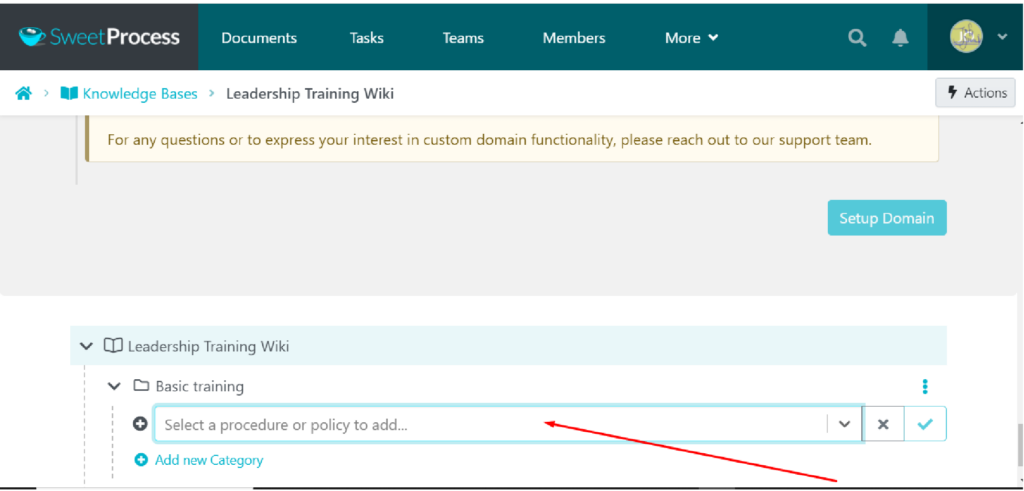
Once you have added all the training documents to your knowledge base, you can share them with the right team members.
Bring Your Procedures to Life With Beautiful Diagrams
Visual aids are a powerful way to enhance employee understanding and retention of processes. Having a process map in the form of an infographic will make it easy for all team members to get the hang of what is required of them at a glance.
With automated flow charts in SweetProcess, you can create detailed, visually appealing process maps that map out workflows and procedures.
While creating your procedure in SweetProcess, the process map automatically pops up. The same happens when team members open the procedure to view or perform a task.
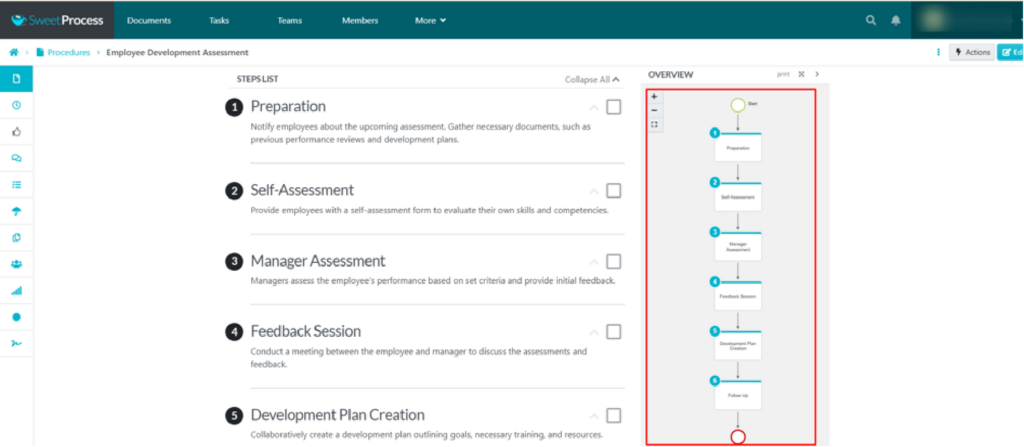
Turn Procedures and Processes into Actionable Tasks
Employee development is more effective when learning is tied to real-world tasks. SweetProcess lets you turn your procedures and processes into actionable, trackable tasks that employees can complete as part of their daily responsibilities.
Assigning tasks directly through the SweetProcess platform helps monitor progress and ensure accountability.
Here’s how to assign tasks in SweetProcess:
To assign a team member to a specific task, follow the practical steps below:
Step 1: Ensure the task is documented in SweetProcess as a procedure.
Step 2: Log in to your SweetProcess account and locate the procedure on the home page.
Step 3: Click on the three dots next to it.
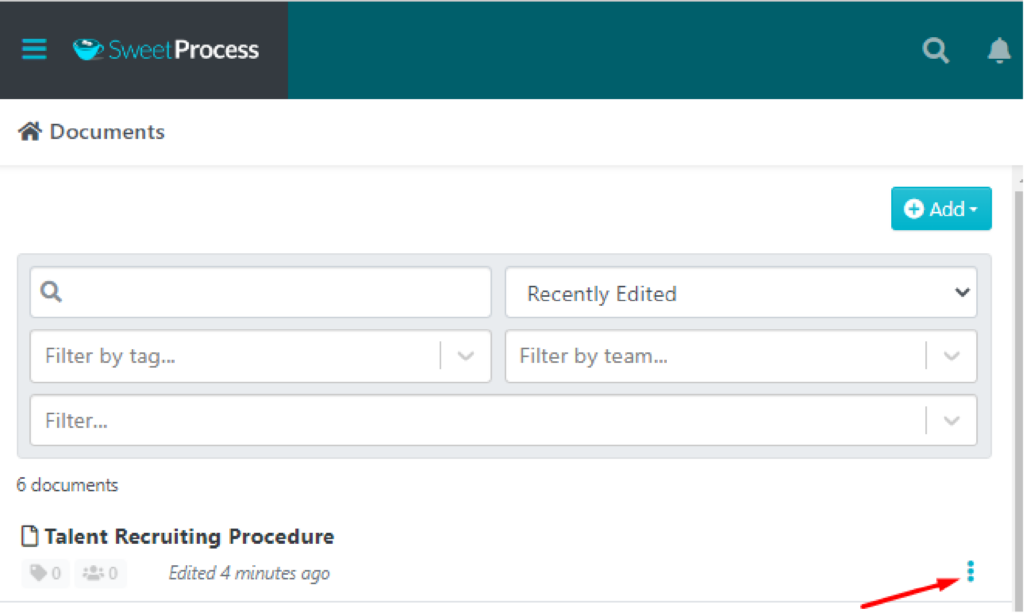
Step 4: Click on “Assign as Task.”
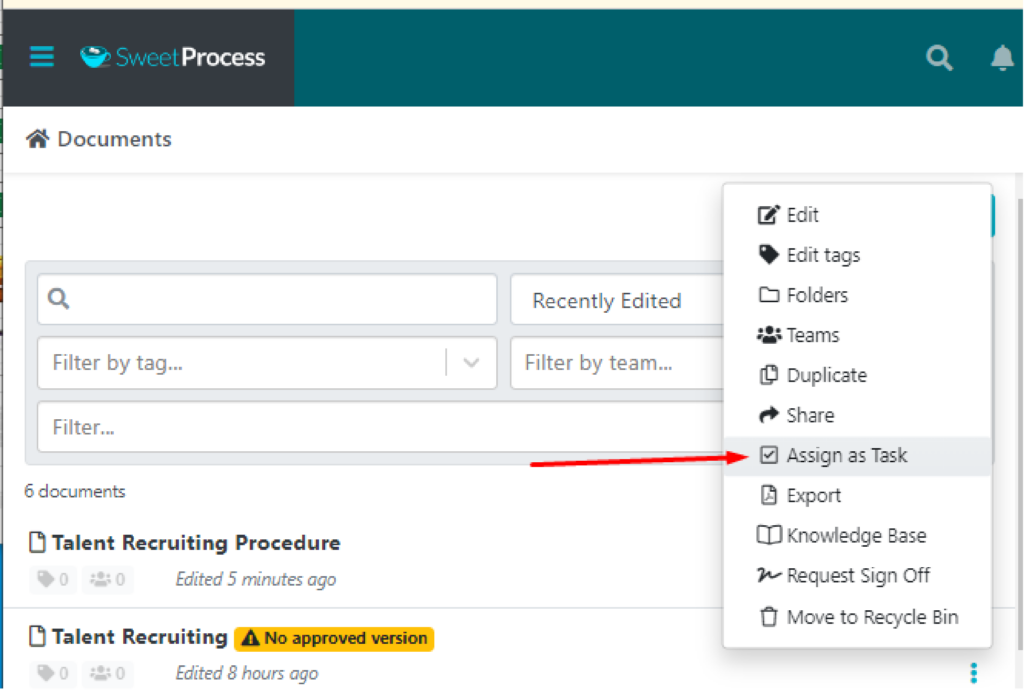
Step 5: Input the required details on the Assign Task dashboard and click “Next.”
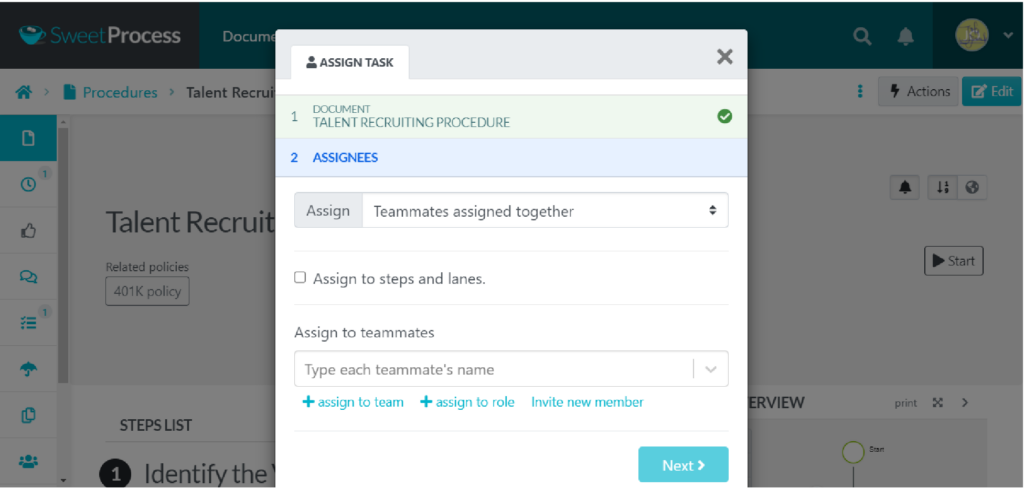
Step 6: Input the task name, due date, and task frequency. You can have a task repeatedly come up as you deem fit, e.g., every last Friday of the month or weekly, monthly, yearly, etc.
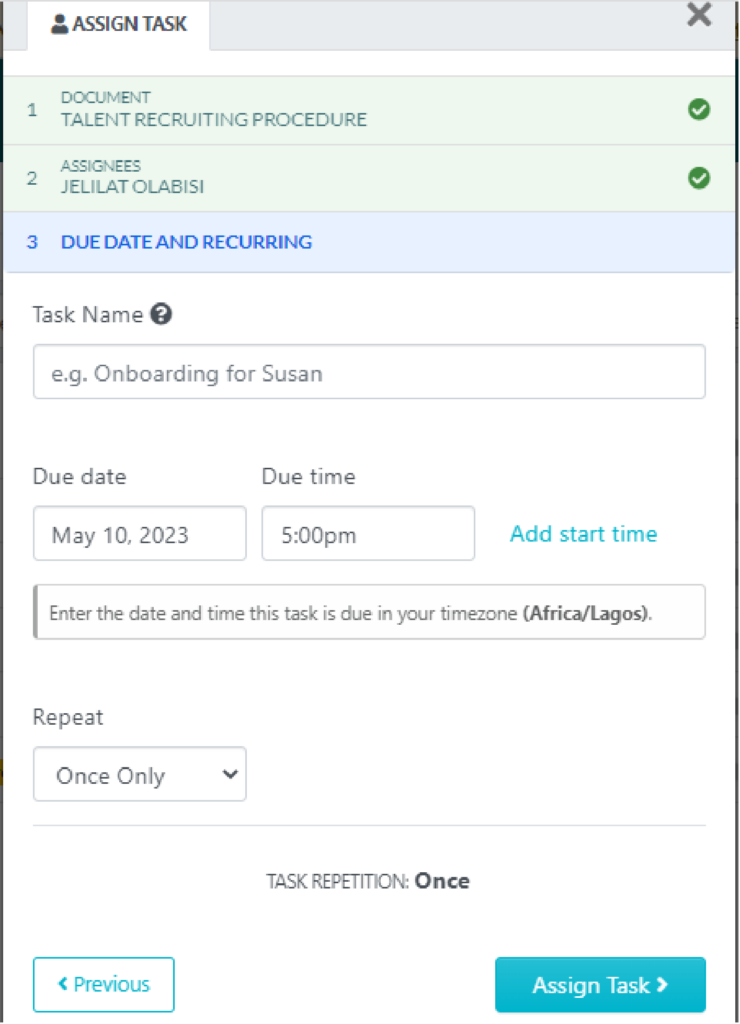
Step 7: Once you click “Assign Task,” the teammates you have assigned will get a notification about the new task assigned to them. You will also get a reminder email on the task due date and whether the job is completed or overdue.
Use the Form Builder to Capture Information From Your Team Members
Gathering employee feedback and input is essential for tailoring development initiatives to their needs. SweetProcess has a form builder feature that makes it easy to incorporate custom forms to capture information from your team. Whether you’re conducting a skills assessment, requesting feedback on training programs, or gathering ideas for process improvements, these forms ensure you stay connected to your team’s needs and insights.
Here’s how to use the form builder feature in SweetProcess:
Step 1: Open the document to which you want to attach a form.
Step 2: Click on “Edit.”
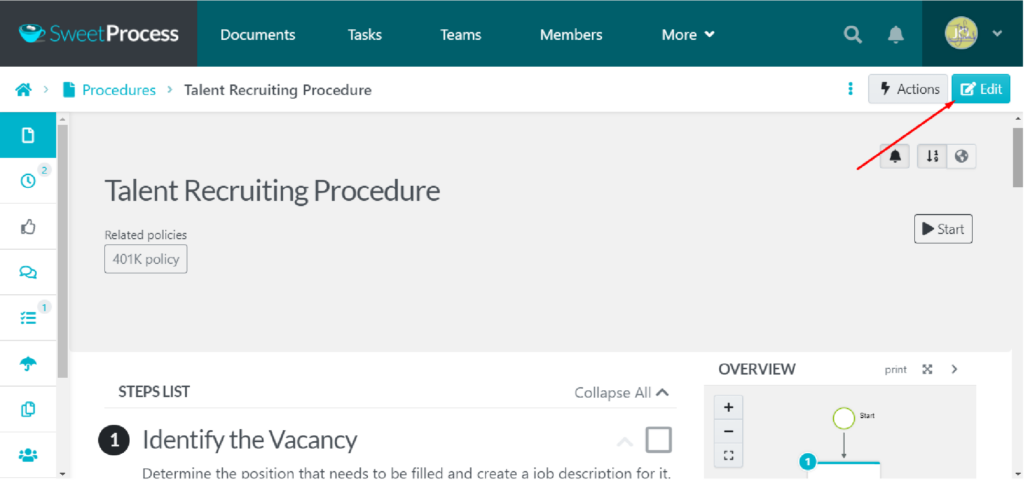
Step 3: Click the pencil icon on the exact step to which you want to attach the form.
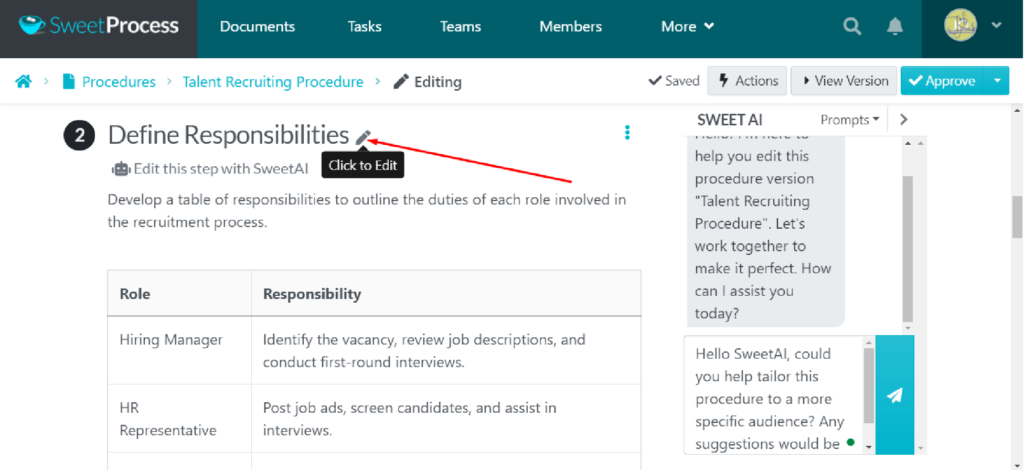
Step 4: Click on “Add Form Field.”
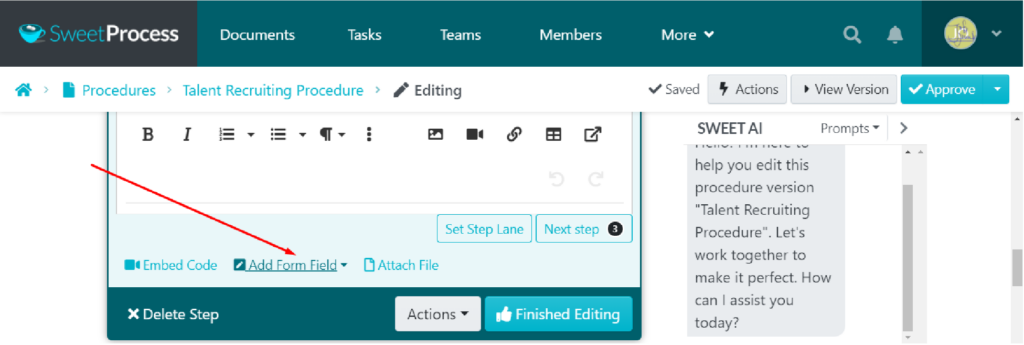
Step 5: Select your preferred form type.
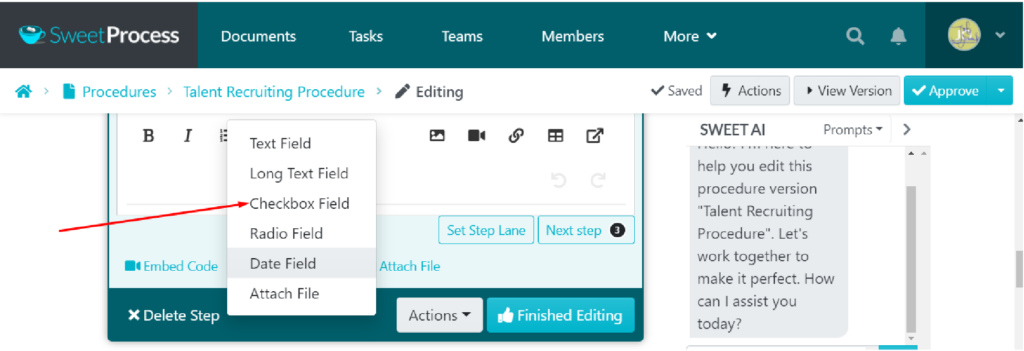
Step 6: Add all the required form fields and click on “Finish Editing.”
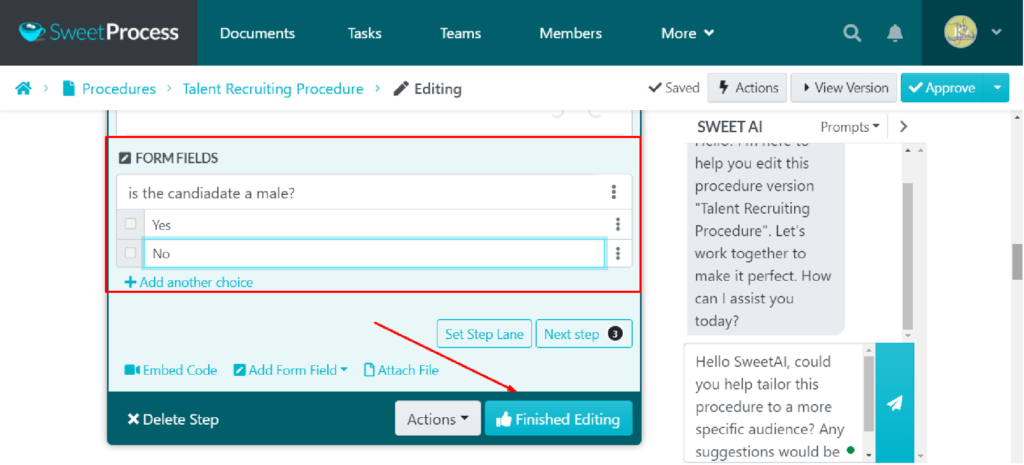
Collaborate and Get Approvals From Managers in Real Time
Collaboration is an indispensable part of employee development. SweetProcess streamlines this by allowing real-time collaboration with managers and team members. You can add comments, share updates, request approvals, and refine development plans with input from key stakeholders—all within the platform.
Here’s how to collaborate in SweetProcess:
Step 1: Log in to your SweetProcess account and open the procedure.
Step 2: Click the comment icon on the left taskbar.
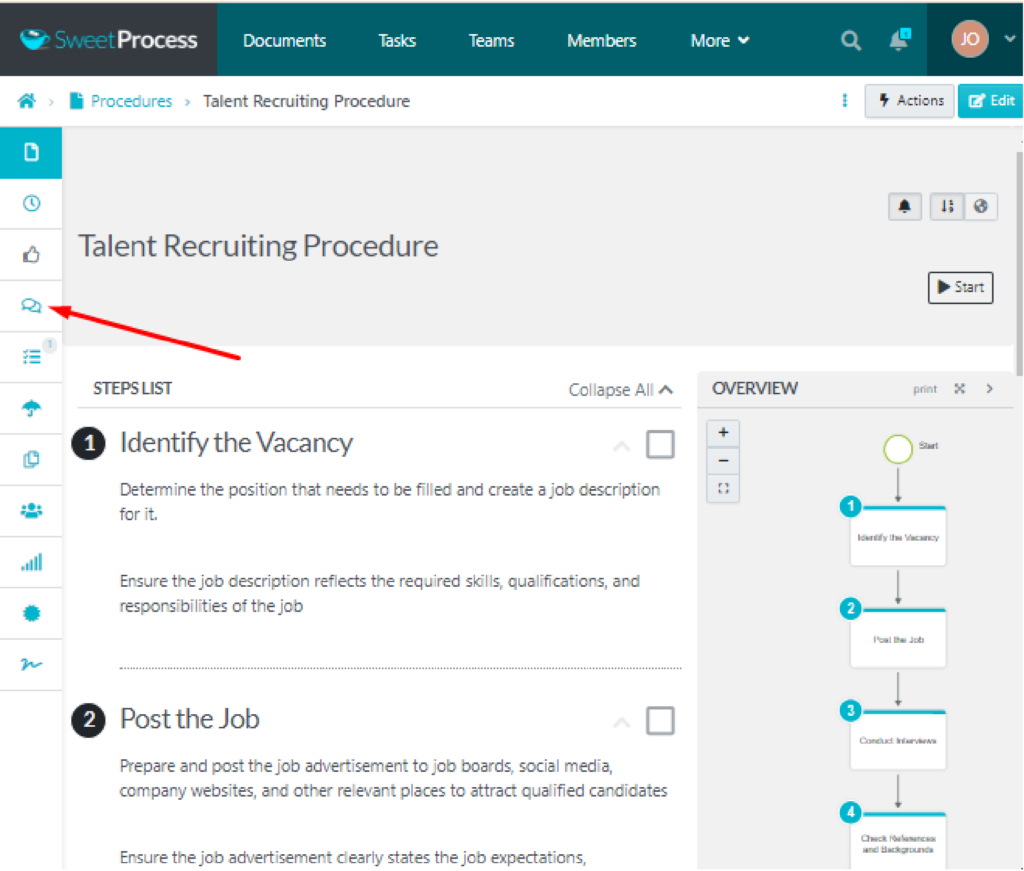
Step 3: Add comments in this section.
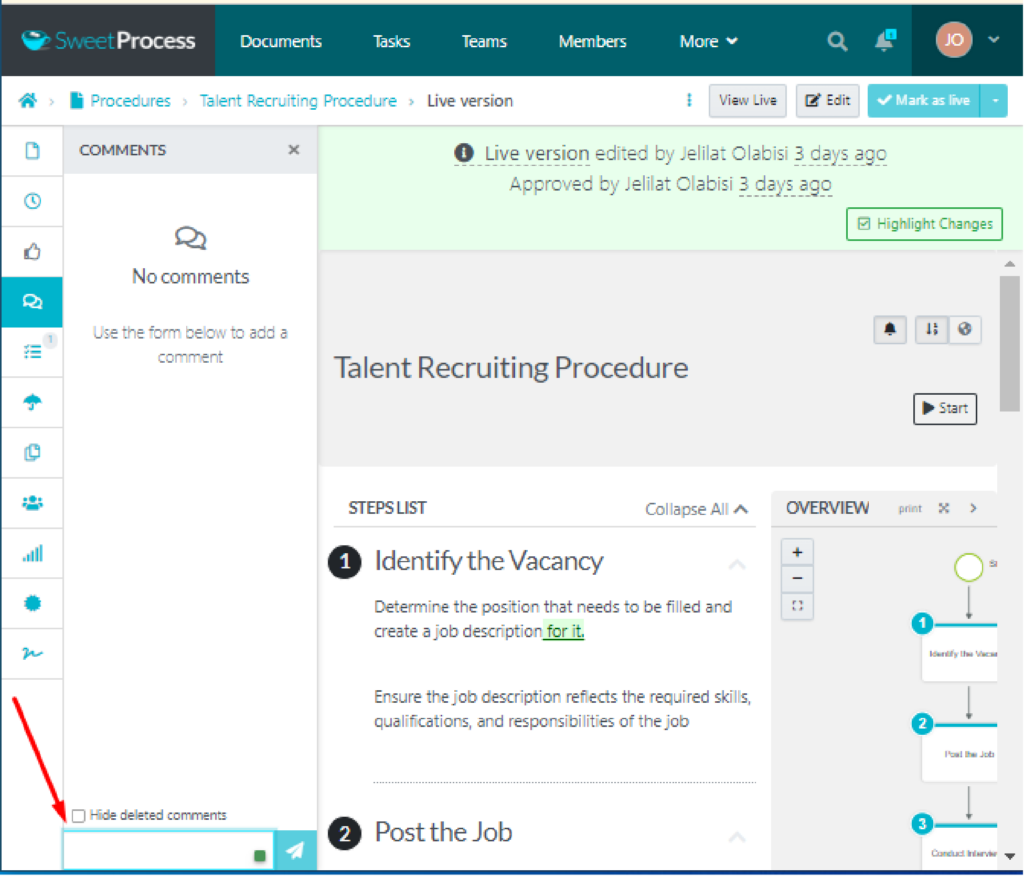
Step 4: You can use the “@” feature to mention team members in between comments, and everyone will be on the same page.
10 Proven Employee Development Methods
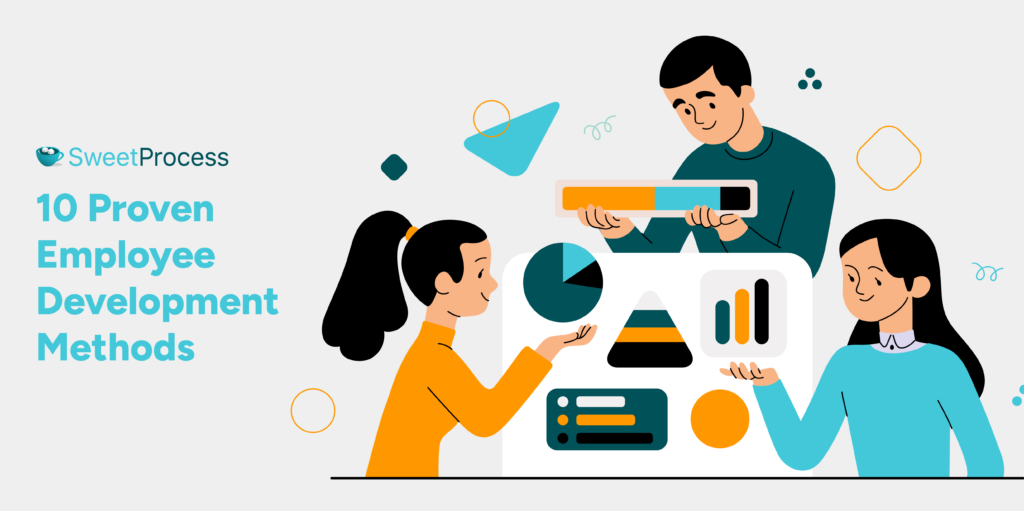
Effective employee development requires diverse methods tailored to meet individual and organizational goals. Here are ten proven approaches used by developmental experts that empower employees, enhance their skills, and prepare them for future challenges:
Mentoring
Mentoring is one of the most effective employee development methods. It provides personalized guidance and support to employees. A senior employee or leader is assigned as a mentor, sharing their knowledge, skills, and experiences to help mentees or junior employees navigate challenges and achieve their career goals.
Google’s Career Guru and Amazon’s Affinity groups are examples of mentoring methods that enhance employees’ career growth and ensure organizational continuity.
The one-on-one nature of mentoring fosters trust, accelerates skill development, and promotes a culture of growth within the organization.
Coaching
Coaching focuses on improving specific skills or competencies through structured feedback and action plans. Unlike mentoring, coaching is often short-term and goal-oriented, with the coach helping employees address specific performance issues or develop targeted skills.
Individual Development Plans (IDPs)
Individual development plans (IDPs) are customized growth roadmaps to align an employee’s career aspirations with organizational goals. IDPs outline specific objectives, required skills, and timelines for achieving these goals, ensuring clarity and accountability. Employees work collaboratively with managers to create these plans, tailoring them to their strengths and development areas. IDPs are thus personalized approaches that enhance motivation and engagement while ensuring that development efforts are strategically aligned.
The 9-Box Grid
The 9-box grid was first introduced in the 1970s by McKinsey & Company as a tool for assessing the potential and performance of employees. It has since become widely used by organizations around the world.
It is a performance and potential assessment tool that helps organizations identify high-performing employees and future leaders. It evaluates each employee based on their current performance and potential for growth, placing them into one of nine categories. This method allows managers to create targeted development plans, focusing resources on nurturing high-potential individuals. The 9-box grid is particularly useful for succession planning and leadership development programs.
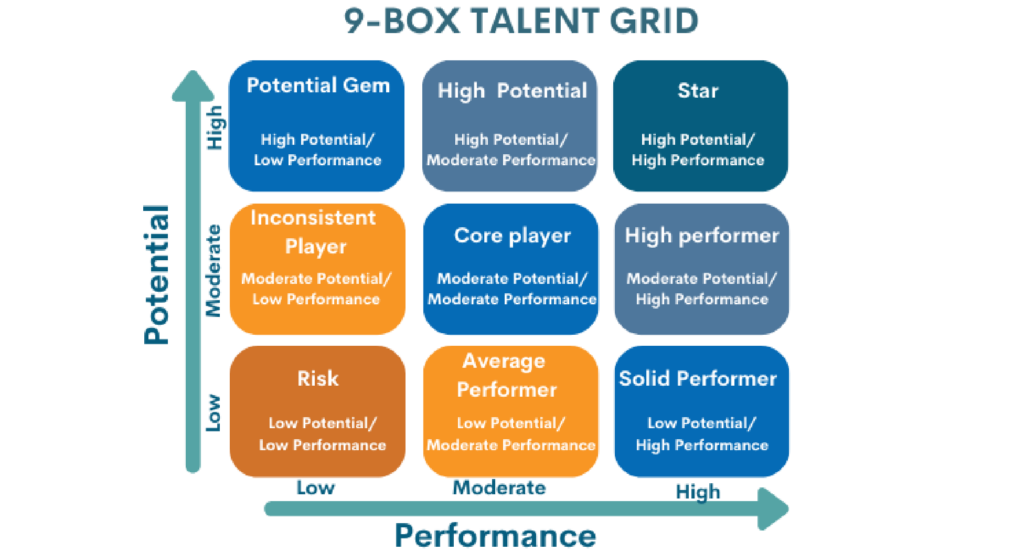
Job Enrichment
Job enrichment enhances employee engagement by adding more variety, responsibility, or autonomy to their roles. This method challenges them to expand their skill sets and take ownership of more meaningful tasks to boost employee productivity.
For example, allowing employees to lead a new project or take on decision-making responsibilities can provide growth opportunities while keeping their work exciting and fulfilling.
Job Shadowing
Job shadowing allows your employees to observe and learn from colleagues in different roles or departments. This hands-on experience provides insight into various aspects of the organization, helping employees develop an encompassing knowledge about the organization.
For instance, a marketing professional shadowing a sales representative can better understand customer interactions, fostering cross-departmental collaboration for profitability.
Cross-Training Simulations
Cross-training simulations prepare employees to take on multiple organizational roles, making them more versatile and adaptable. This method involves replicating real-life scenarios to teach employees how to handle tasks outside their primary responsibilities. For example, a customer service agent might be trained in basic IT troubleshooting to provide better support during technical issues. Cross-training enhances team flexibility and ensures business continuity during absences or transitions.
Conferences
Attending industry conferences exposes employees to the latest trends, technologies, and best practices in their field. These events provide networking opportunities, inspire innovation, and help employees stay ahead in a competitive market.
On-the-Job Training
On-the-job training is a practical and cost-effective development method where employees learn by performing their duties under a supervisor’s or experienced colleague’s guidance. This approach allows employees to acquire relevant skills and knowledge while contributing to the organization. For example, a new team member might shadow a senior and experienced employee during their first week, gradually taking on responsibilities as they are being trained.
Self-Study
Self-study empowers employees to take control of their development through independent learning. This method can include reading books, watching online tutorials, or completing e-learning courses. Organizations can help employees stay motivated and proactive in their professional growth by providing access to learning resources and encouraging a growth mindset. For instance, a project management company could provide employees with access to platforms like LinkedIn Learning or Coursera to master new tools or methodologies at their own pace.
Challenges of Employee Development and How to Overcome Them
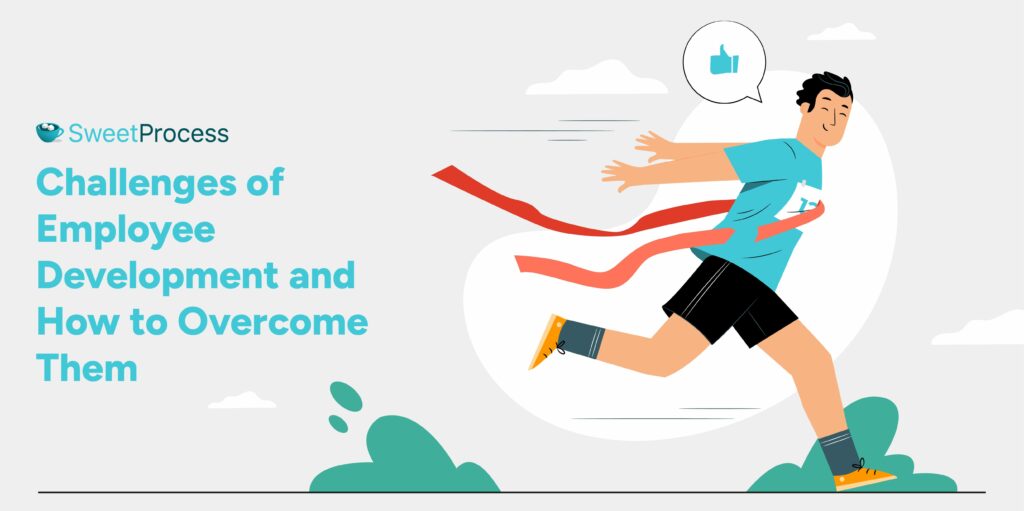
Commitment to employee development does not come on a gold platter. It faces several challenges. Overcoming these challenges requires strategic planning, effective communication, and tailored solutions to benefit employees and the organization. Some of the challenges you may have in the process are discussed with their solutions below:
Lacking Talent Development Capabilities
Many organizations struggle with insufficient resources or expertise to design and implement effective development programs. This lack of capabilities can result in generic training sessions that fail to address real needs.
Solution: Organizations should invest in upskilling their HR and management teams to design strategic development initiatives. Partnering with external experts, such as professional trainers or learning consultants, can also bridge this gap. Learning platforms like SweetProcess or LinkedIn Learning can streamline program design and delivery.
Inconsistent Execution
Even the best development plans can fail if they are inconsistent. Factors like unclear communication, lack of follow-up, or misaligned priorities often lead to inconsistent implementation.
Solution: Your organization should create clear and actionable development roadmaps with specific timelines, milestones, and responsibilities. Regular check-ins, automated reminders, and tools like task trackers ensure that training and development activities stay on course and yield tangible results.
Lack of Analytics Tools
Without data, measuring the impact of development initiatives or identifying areas for improvement is challenging. Many organizations lack the tools to collect and analyze data on program effectiveness and employee progress.
Solution: Implementing analytics platforms or tools, such as LMS (learning management systems), can provide insights into employee performance, engagement, and skill growth. For example, tracking progress and quiz scores on SweetProcess can help managers refine training programs based on measurable outcomes.
Development Needs of Each Employee
A one-size-fits-all approach to employee development often overlooks individual needs. This makes some employees feel disengaged or unsupported.
Solution: Addressing this requires a personalized approach, such as individual development plans (IDPs) tailored to each employee’s goals, strengths, and areas for growth. Regular one-on-one meetings between managers and employees can help identify specific needs and create customized development strategies.
Lack of Accountability
When accountability is missing, development programs can lose momentum, and employees may not take them seriously.
Solution: Development managers should set clear expectations and tie development goals to performance evaluations or career advancement opportunities. Using tools that track progress and completion rates can also foster accountability.
No Alignment Between Workers and Business Strategy
Development programs that don’t align with organizational goals often fail to deliver meaningful results. Employees may acquire skills that don’t benefit the company, leading to wasted resources.
Solution: Employee development should be part of the overall business strategy. It requires identifying the skills and competencies needed to achieve organizational objectives. Then, design training programs that bridge skill gaps while ensuring employees understand how their growth contributes to the company’s success.
If these challenges are strategically addressed, organizations can build a robust and effective employee development program that fosters growth, engagement, and measurable success.
Types of Employee Development

Employee development can either be career development or professional development.
Career Development
Career development focuses on helping employees define and achieve their long-term career goals within or outside the organization. This type of development is a selfless effort by organizations to ensure upward mobility, skill diversification, and role transitions for their employees.
Career development initiatives often include mentorship programs, succession planning, and individual development plans (IDPs). These activities allow employees to map a clear path for their professional future. For example, an employee aspiring to move into a management role might participate in a leadership training program or take on stretch assignments to build the necessary skills.
Professional Development
Professional development is centered on enhancing employees’ skills and competencies to improve their performance. This can include technical training, certifications, workshops, or attending industry conferences to stay up-to-date with the latest trends and best practices. For instance, a project manager might pursue a PMP certification or attend seminars on agile methodologies to sharpen their expertise and increase their value to the organization.
Professional development will improve job performance and foster a culture of continuous learning and innovation. Organizations prioritizing this development will gain a competitive edge by keeping their workforce skilled and adaptable to industry changes.
The customer experience director at Preferred Home Services, Katie Sullivan, once shared her thoughts on how SweetProcess helped her train their employees. Apart from the processes that are easily documented in one place, training and onboarding new and existing employees became a breeze when Katie adopted SweetProcess.
According to her, “When I brought on our marketing coordinator, I was able to get them started with a task, and they lived through the first week of onboarding completely self-guided and self-controlled. It was one of the smoothest onboarding processes I’ve ever had that they could hit the ground running in week two,” Katie recounts.
The same experience was replicated with the Thimbleberry Financial team. Amy Walls, who led the financial experts, shared her experience of how SweetProcess became a game changer in their employee training and development.
In her words, “Our new employees say they have never gone through a more organized onboarding. We have one or two SweetProcess procedures that they work through. They start on their first day. When they start, we literally have them get access to three things. One is their email. One is SweetProcess, and one was our Slack channel, but now it’s Teams,” Amy says.
Implementing Employee Development in an Organization: Different Approaches To Explore
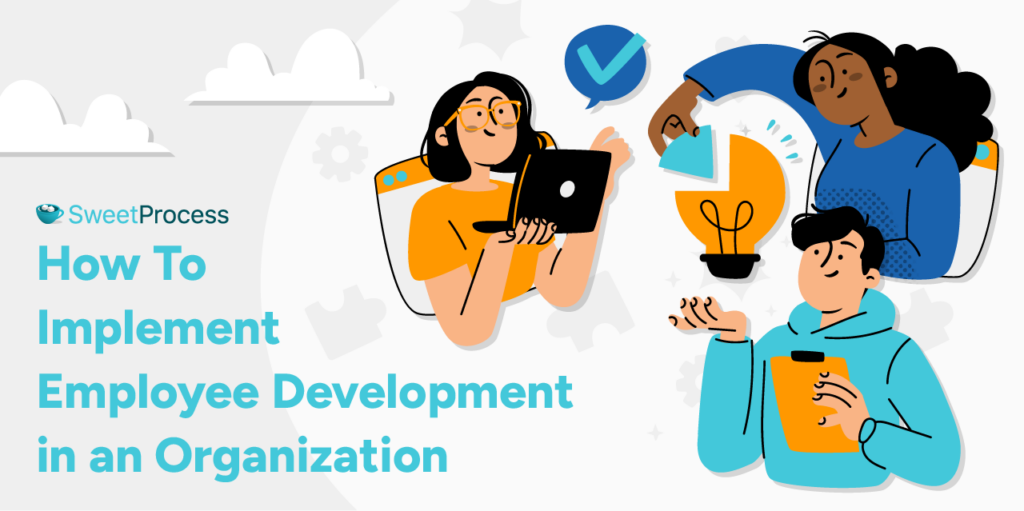
Implementing employee development in an organization requires a variety of approaches to meet diverse learning needs and align with business goals. Some of the most common approaches are:
Formal Education
Formal education is a structured approach to employee development. It involves courses, certifications, and degree programs designed to enhance knowledge and skills. Organizations can sponsor employees to attend external training programs, enroll in higher education, or take professional certifications related to their roles.
Assessment
Assessment is a crucial step in identifying development needs and measuring progress. This can include performance appraisals, 360-degree feedback, skill gap analysis, and behavioral assessments. Tools like psychometric tests or leadership skills assessments help organizations determine areas where employees excel and areas needing improvement.
Interpersonal Interactions
Interpersonal interactions, such as mentoring, coaching, and networking, can contribute significantly to employee development. These approaches facilitate knowledge sharing, relationship building, and real-world problem-solving.
Individual and Team Development
Employee development should cater to both individual growth and team dynamics. Individual development focuses on personal goals and skill-building, such as offering tailored training programs or crafting individual development plans (IDPs). Team development, on the other hand, emphasizes improving collaboration, communication, and synergy among group members. Team-building exercises, group workshops, or cross-functional training sessions can enhance team cohesion and performance.
Role Play & Hands-on Job Experience
Role-playing and hands-on job experiences allow employees to learn by doing, which is one of the most effective skill development methods. Simulated scenarios, such as conflict resolution exercises or customer service role play, help employees practice real-world challenges in a safe environment. Similarly, hands-on experiences, like job shadowing or temporary project assignments, provide practical learning opportunities.
Stages of Employee Development
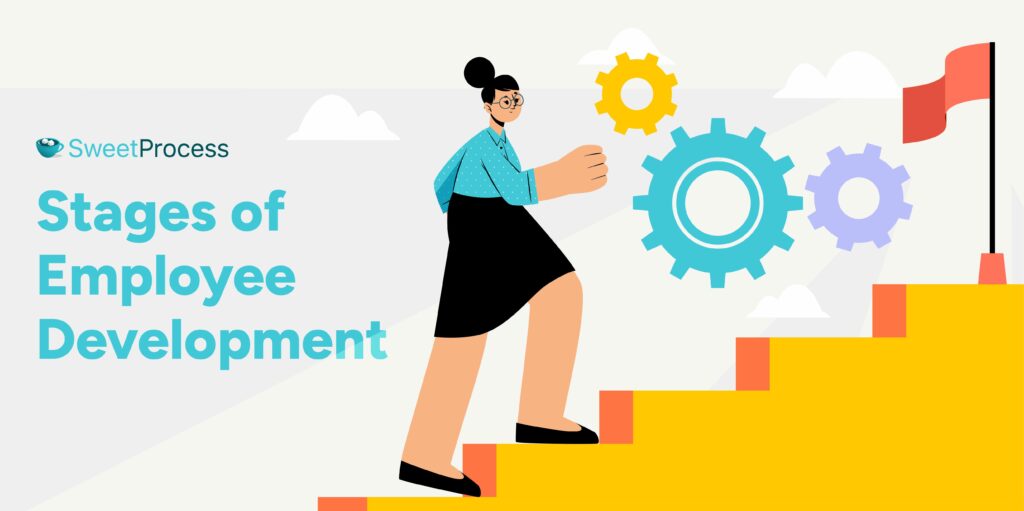
Employee development is not a one-day job. If you’re ready to give it a try, here are the steps to follow:
Attraction
The first stage of employee development begins with attracting the right talent. Organizations must create a compelling employer brand that highlights their organization’s culture, growth opportunities, and commitment to employee success. A strong attraction strategy ensures the organization draws in individuals who align with its values and goals. This is where you set the foundation for long-term success.
Recruitment
The recruitment stage is the time to select candidates whose skills, experiences, and aspirations align with the organization’s needs and culture. A well-structured hiring process, including competency-based interviews, assessments, and cultural fit evaluations, ensures the organization identifies the best talent. Effective recruitment doesn’t just fill a vacancy; it brings in individuals with the potential to grow and contribute meaningfully to the company.
Onboarding
Employee onboarding is a critical stage where new hires are introduced to the organization’s culture, policies, and expectations. A robust onboarding process helps employees acclimate quickly, ensuring they feel supported and engaged from the first day. This stage can include orientation sessions, mentorship programs, and detailed training on roles and responsibilities.
Development
Employee development is the core stage, focusing on continuous learning and growth. This includes training programs, professional certifications, coaching, and mentoring. At this stage, organizations will invest in enhancing employees’ skills and competencies to meet current and future needs.
Retention
Retention ensures that talented employees remain with the organization over the long term. This stage involves creating a positive work environment, offering competitive benefits, and recognizing employees’ contributions. Regular feedback, career growth opportunities, and work-life balance initiatives play a vital role in retaining top talent.
Separation
The final stage of the employee development plan is separation, which occurs when employees leave the organization, whether due to retirement, career changes, or other reasons. Managing this stage effectively involves replacing departing employees and ensuring a smooth handover process. A well-handled separation can lead to brand advocacy and even the possibility of rehiring in the future. For example, keeping alumni engaged through a company network can turn former employees into valuable advocates or partners.
Each stage of the employee development program plays a crucial role in shaping and developing employees’ journey. They contribute to both individual success and organizational growth.
Streamline Your Employee Development Using SweetProcess
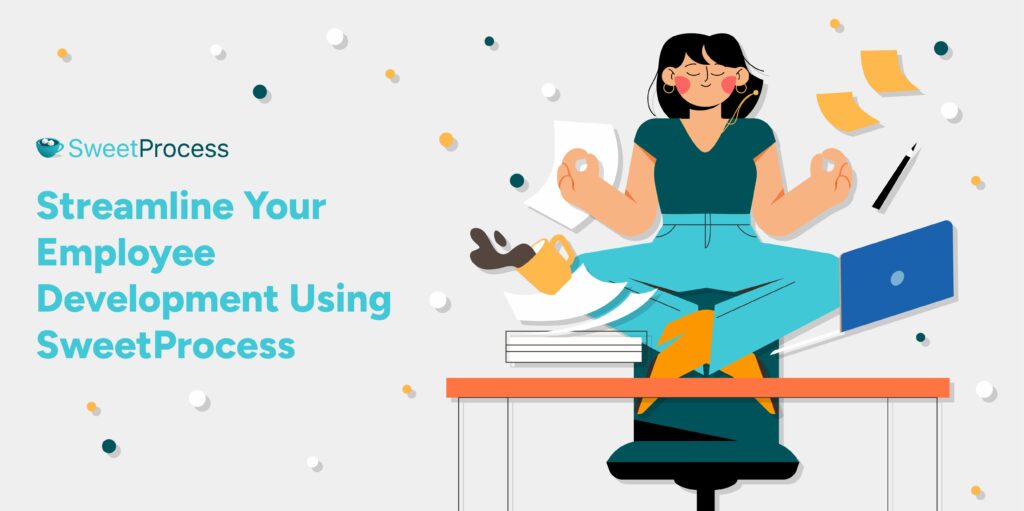
Recent research has shown that employers get an average of $7 ROI for every $1 spent on employee development. Since employee development is such a profitable venture, employers must participate in this great investment.
Employee development is not only helpful for employees to advance in their skills and careers, but it also helps an organization keep an inventory of team members who can take up any role at any time.
Choosing SweetProcess could give you a leap if you’re on your employee development journey. This was Ted Fogliani’s experience at ShipCalm, which was experiencing many issues during its organizational growth.
According to this happy CEO who chose SweetProcess, “I can assign people to be trained on tasks, and I can track that training. I come from manufacturing medical devices, where I actually had to prove to the FDA that my people touching it were approved.“
